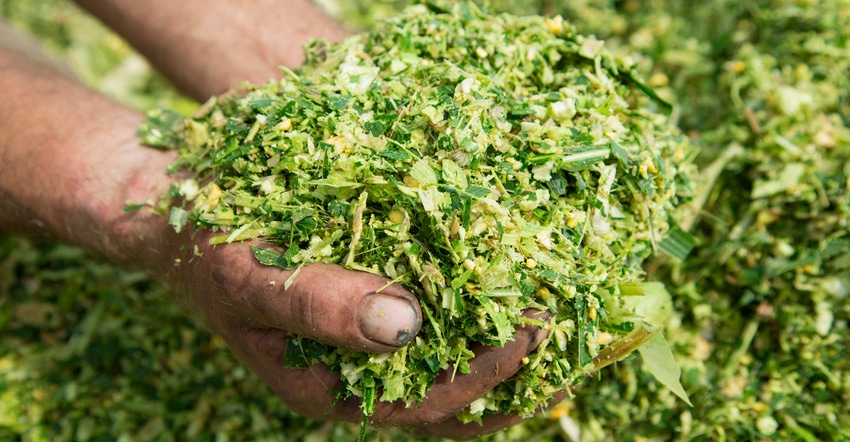Silage Maker Inoculants… Feed the Finest Forage Possible
Silage Maker Inoculants… How to Feed the Finest Forage Possible
May 1, 2021

Sponsored Content
By Christopher M. Peter, Ph.D., Dairy Technical Service and Research Scientist and Ricardo P. Arias, Ph.D., Manager of Dairy – Specialty Products & Technical Service at United Animal health
As haylage season is rapidly approaching and corn silage season is only a few months away, it is a good time to review and enlist one of the most researched tools that a dairy producer has at their disposal, silage inoculants. Forages represent the dairy’s number one feed cost and, thus, should be viewed as more than just a cost, but a valuable investment. The Silage Maker brand of inoculants from United Animal Health have been developed and researched to enable you to Feed the Finest Forage to recoup the maximum possible benefit from that investment. First and foremost, nothing will ever replace good forage management, but inoculants simply allow for a little greater margin for error throughout the harvest season. Why?
We first must acknowledge that due to the native bacteria on plants, silage fermentation will occur naturally under anaerobic conditions, whether we use inoculants or not. For this reason, and because most times you can’t pick up nutritional quality differences in silages by just looking at or smelling a sample, you find people that do not believe in bacterial inoculants. However, decades of scientific research have demonstrated that the speed and efficiency of the fermentation process vary greatly from year to year, field to field, and crop to crop; and that fermentation depends on the quantity and type of bacteria present on the crop. Think of it as beer brewing (even though when brewing beer, we look for a different type of fermentation and pretty much the opposite to happen: aerobic conditions, yeast fermentation, produce alcohol and CO2; the same principles apply), fermentation will be slow or won’t start at all if you don’t pitch enough yeast in the wort; or, you will get overly fruity aromas or buttery flavors if you use the wrong strains of yeast. In silage, the bacterial species and strains will affect the speed of pH drop, which affects the amount of sugar used by the bacteria, the preservation of true protein, the quantities of lactic, acetic, and butyric acids produced from those sugars; and ultimately, the quality of the final product. In addition, there are two key processes that will determine your success in preserving forages in the form of silage. 1) The creation of an anaerobic environment; and 2) The fermentation of sugars by lactic acid bacteria to lactic acid and other products. Both processes are equally important to good preservation, and one cannot replace the other. Furthermore, the two can only be controlled via management (harvest timing, moisture content, compaction, quality and timely cover, inoculant use, face management, etc.)
The goal of bacterial silage inoculants is to overwhelm the native bacteria on the forage to ensure a more efficient fermentation process, that preserves more of the nutrients the cows need. Lactic acid bacteria (LAB) produce lactic acid as their principal product from fermenting sugars, but other products such as acetic acid, ethanol, water, and carbon dioxide are also produced during fermentation. It is important to keep in mind that silage additives (for the most part) don’t have the capacity to improve the nutritional characteristics of your forage. The main goal of using microbial additives, is to manipulate the fermentation process to PRESERVE the nutrients already present in the forages. There are, however, improvements in starch digestibility, protein solubility, NDF digestibility, aerobic stability, and palatability with the use of some inoculants that contain specific strains and enzymes.
There are two main types of silage inoculants: the traditional homofermentative types, and the most recent inoculants that use heterofermentative bacteria. A third type, combining homofermenters with heterofermenters is also available. To make things easier, just remember that homo means same or one, and hetero means different. Thus, homofermenters always produce the same product (Lactic Acid), whereas heterofermenters produce a few different products, making the first one the most energy-efficient of the two.
During homofermentation, each molecule of sugar yields exactly two molecules of lactic acid, resulting in high dry matter recovery and little energy loss from the silage. In addition, lactic acid is a strong acid that reduces silage pH faster and lower than other acids. Thus, homofermentative strains rapidly create an environment that undesirable anaerobic strains don’t like, this prevents further breakdown of the sugar and protein in the crop, increases dry matter recovery, and has actually shown to improve animal performance in several university studies. Homofermentative bacteria species include: Lactobacillus plantarum, Enterococcus faecium, and the Pediococcus species.
In contrast, during heterofermentation, one molecule of sugar yields one lactic acid, one acetic acid or ethanol, and one CO2. Carbon dioxide leaves the silage as a gas, resulting in dry matter loss, acetic acid is not a strong acid like lactic, therefore the decline in pH is slower (hence the increased loss in nutrients), and ethanol has no effect on pH. Additionally, heterofermenters are slow growers and take 45 to 60 days of storage time before having much effect on the fermentation process. Nevertheless, the added acetic acid does inhibit yeast and mold growth, which increases aerobic stability of silages at feeding. Heterofermentatives include: Lactobacillus brevis and Lactobacillus buchneri.
Having multiple strains in a product is best. These strains of bacteria have variable growth rates depending on presence/absence of oxygen, temperature, pH, and moisture. Thus, having several strains in a product gives you a more effective product for a broader range of conditions. In addition, there are synergistic effects between the various strains.
The homofermentative-based strains in Silage Maker brand inoculants from United Animal Health when used in combination with Silage Maker Mold Inhibitors, however, have been shown to result in not only efficient fermentation over the varying pH ranges, but also outperform L. bucheri-based products in terms of reducing secondary fermentation and ration heating. This proven combination, therefore, allows producers to Feed the Finest Forage possible. Please stay tuned for more specific recommendations in the next issue.
About the Author(s)
You May Also Like


